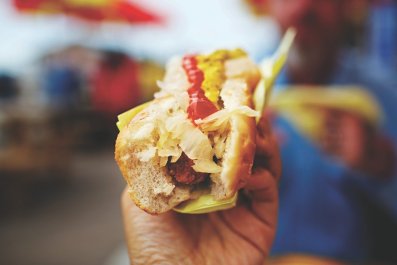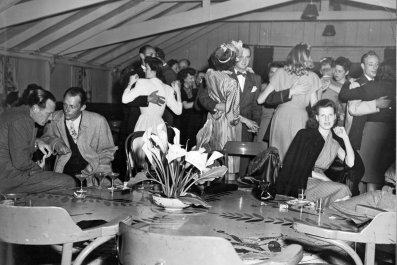To see and taste what's next in American cuisine, venture into the long-neglected but recently resurgent cluster of skid rows and skyscrapers known as downtown Los Angeles. Search for the sign, on Olympic Boulevard, of Club Las Palmas: the one that reads "Hostess Dancing" in flashing lights. Then go next door, through the only façade on the rather deserted, dilapidated block that's paneled in artfully weathered wood, to a diminutive storefront restaurant called Alma.
Inside, the place looks more like a temporary catering operation or improvised wine bar—plain white walls; bottles, books and herbs stacked on open shelves; a chalkboard on which someone has scrawled "Alma"—than what it is: The Best New Restaurant in America, according to the August issue of Bon Appétit magazine. And the lean and hungry fellow calling out orders from one end of the white Corian bar looks more like an enthusiastic intern—elfin ears, postcollegiate beard—than the 27-year-old maverick chef responsible for some of the most fascinating and forward-thinking food of 2013.
In America, it used to be that a chef's job was to cook the stuff that his or her customers liked to eat. But about a decade ago that began to change, and ever since, the country's most celebrated chefs have gotten famous by cooking the stuff they like to eat: David Chang's rock-and-roll Asian-American fare; the muscular, meaty creations of Vinny Dotolo and Jon Shook at Animal in L.A.
Alma's Ari Taymor is different. In a move that owes more to esoteric European masters such as Andoni Luis Aduriz of Mugaritz than to his American peers, Taymor is not quite cooking the food he likes to eat, per se (although he likes to eat all of it). Instead, he is cooking the food he likes to feel, to ponder, to remember.
"My food is personal food," Taymor explains. "It's really about putting flavors and textures and temperatures together in a way that's inspired by memory, or is perhaps something that I want to say. That way I can share a part of my life with people, and leave it open for them to interpret however they want."
On a recent Wednesday night, Taymor's vision took the form of a two-hour, $90 tasting menu, which began with a parade of bright, immaculate "snacks"—a single Pacific oyster steeped in a rich green watercress sauce; a petite English muffin heaped with uni, burrata, caviar, and licorice herbs; a sunchoke and beef tartare taco; a seaweed and tofu beignet—before the first of the evening's nine courses even arrived. Taymor started cooking in college—relatively late for a chef of his stature—for reasons that were as personal as his cuisine now professes to be: a childhood spent inhaling Taco Bell chalupas combined with a genetically dysfunctional gallbladder left him doubled over for 16 hours at a time in excruciating gastrointestinal pain. "It required me to think about what I put into my body, and ultimately, what other people put into theirs, "Taymor says. "It really influenced how I cook."
As a result, Alma's most indelible dishes are also its quietest. "We don't season food with a lot of salt or acid," Taymor says. "And we don't use a lot of fat or butter—hardly any at all. It's really the polar opposite of what they're doing at Animal." Frozen niblets of bourbon-infused duck liver with smoked maple, sous-vide carrots, coffee granola, and fennel pollen taste like the first winds of autumn; slices of raw pear, crisp kale flakes, a sprinkling of ginger "snow," and a pool of fermented cabbage purée transform a few simple shreds of Dungeness crab meat into something even sweeter and crabbier than crab itself.
Perhaps the most surprising dish on the tasting menu, and the most personal, is a dessert called Frozen Summer, in which chamomile semifreddo, licorice ice cream, sorrel sauce, lemon-balm meringue, and herbs such as marigold, wild fennel, and chamomile flower combine to evoke the childhood summers Taymor spent in the Santa Cruz mountains—a place where, as Taymor puts it, "these really cold, foggy, wet mornings would break in the afternoon, and where the smells of wildflowers and wild herbs and grasses would intensify as the sun began to emerge." When the chef places the dessert in front of a diner—Alma is so intimate that even Taymor runs food—he never tells its origin story. "I want them to understand the sentiment of the dish as opposed to the components," he explains. "But because there is that particular emotion behind the conception of it, I think it comes through."
Will Taymor's brand of gentle, introspective, avant-garde cooking supplant the trendy, testosterone-rich comfort food of the past several years? In Los Angeles, at least, Alma spent its first nine months of existence as something of an outlier; a visit last March found the tiny space half-empty. But since August—since Bon Appétit released its list—the restaurant has become one of the toughest reservations in town, drawing diners from across L.A.'s notoriously sprawling metropolitan area to the unlikeliest corner of the city, for some of its unlikeliest food.
As she settled in to dine at the bar, a recent divorcée who was about to sell her downtown loft and move to Massachusetts explained why she had finally decided to try Alma. "I knew it had gotten good reviews, but then I heard on NPR that it was the best new restaurant in America," she said. "Right in my backyard? I knew I had to come before I left Los Angeles."
























